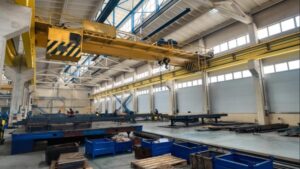Artificial intelligence promises to revolutionise conventional order fulfilment technology. By leveraging AI in warehousing, you will achieve greater productivity while minimising your operating expenses.
1. Enhanced Quality Control
Many tools can pick and package products, but how many can ensure their work is correct? Order fulfilment technology for quality control leverages computer vision and image recognition to identify anomalies. AI analyses the feed in real time, catching defects and mistakes before they make it to customers.
2. Better Demand Management
If you are unprepared for demand spikes, you risk being unable to keep up — diminishing customer satisfaction and revenue. AI-powered robots and collaborative robots (cobots) can operate during your off-hours and on employees’ breaks, enabling continuous order fulfilment.
These machines are no longer just conceptual. For example, the SIMATIC Robot Pick AI technology — a cobot driven by deep-learning computer vision software — can perform 1,000 picks per hour on average. Since humans can only consistently achieve 50-150 picks in the same span, algorithm-powered technology is the ideal choice.
3. Reduced Operating Expenses
Warehouse order picking is time-intensive and costly. In fact, it makes up 55% of operating expenses on average. Notably, most of the cost comes from labour — meaning a few strategic terminations in favour of AI-powered technology can lead to tremendous savings.
Reducing your reliance on manual labour minimises your operating expenses dramatically. If you do not consider layoffs the best move, consider adopting telework practises. Shifting warehouse workers to remote administrative roles — and using AI order fulfilment technology — will effectively thin your workforce while retaining your top talent.
4. Higher Employee Satisfaction
It goes without saying that warehouse workers are foundational for order fulfilment. Ironically, picking is a particularly unfulfilling task — meaning many quickly tire and become demoralised. If you tap into the power of AI surveillance or wearables, you can analyse their behaviour to optimise their schedules, picking routes and placements.
This concept also applies to remote work since teleworkers can fulfil orders in hybrid environments. Using AI in warehousing to analyse order patterns, productivity rates and mood improves job satisfaction. More importantly, it helps you achieve optimal productivity and retention rates.
5. Improved Demand Forecasting
To some extent, consumer demand is easily predictable — their interests will always shift during seasonal changes and holidays. However, not all sales patterns are as easily recognsisable. AI can track market trends, real-time data feeds and historical purchasing behaviour to forecast when and what Europeans want to buy.
When you leverage AI, you can reliably determine what trends will be and when they will occur. This way, you can avoid stockouts or overstocking. Also, you can gain a competitive edge in the oversaturated B2C market, ensuring revenue stability despite variable demand.
6. Fewer Workplace Injuries
As you know, warehouses can be dangerous places. After all, workplace injuries cost the European Union £476 billion annually. AI-powered cobots could be revolutionary in this regard, as they are specially designed to work side-by-side with humans.
These machines leverage computer vision and image recognition to keep their articulated arms and moving parts a safe distance from warehouse workers. On top of improving factory floor safety, you avoid the headache accompanying occupational injury paperwork.
7. Diversified Order Fulfilment
Europe’s e-commerce market is growing at an exponential rate. Experts predict it will double in size between 2023 and 2028, hitting a record high of £699.5 billion in less than a decade. As you can see, hybrid order fulfilment technology will soon become critical for outpacing consumer demand.
Standard hybrid fulfilment — a combination of dropshipping, third-party and in-house — is convoluted and can lead to errors. With AI in warehousing, you can ensure timeliness and accuracy even if you are on a digital nomad visa working in a distant country.
8. Streamlined International Expansion
If Americans are good at anything, it is spending money. The U.S. business-to-consumer (B2C) e-commerce market is set to grow from £715.8 billion in 2023 to £1.18 trillion in 2028, a staggering 67.5% growth. If you leverage AI, you can streamline international expansion efforts.
AI can send real-time critical alerts and collect operational data to improve collaboration. Whether you hire locally or employ remote European workers, you improve diversification, reduce overhead costs and gain a competitive edge in an oversaturated B2C market.
9. Enhanced Location Identification
With Europe’s B2C e-commerce market on the rise, identifying future warehouse locations is critical. With AI-powered predictive analytics, you can use historical and real-time data to forecast needs. This way, you can proactively select new sites, fulfilling orders wherever demand will be high.
10. Improved Customer Satisfaction
As great as it would be for your job to end after distribution, it does not. If customers are not satisfied, you risk a hit to your revenue. Considering European consumers generally have at least two weeks to return a product for any reason, you risk having to issue full refunds.
Fortunately, you can use order fulfilment technology to increase customer satisfaction. AI can track their purchasing behaviour and preferred delivery times, making their experience as seamless as possible. Additionally, it can provide real-time shipping updates, reducing supply chain errors.
AI-Powered Order Fulfilment Technology Is the Future
If you leverage algorithm-powered order fulfilment technology in your warehouse, you stand to improve retention, increase revenue and gain a competitive edge in B2C and B2B markets. Since e-commerce and AI are growing exponentially, there has never been a better time to consider implementation.






